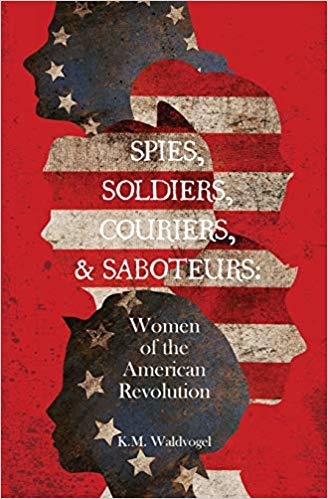K.M. Waldvogel’s Spies, Soldiers, Couriers, & Saboteurs: Women of the American Revolution is an engaging introduction for women’s roles during the fight for American independence.

Waldvogel establishes a brief history of what led to the Revolution well, and her narrative stories bring the reader directly into the moment. We ride with Sybil Ludington across harsh countryside, become brave in the face of British soldiers with Emily Geiger, and even sneak into a prison with Mammy Kate. Each chapter is a story, brought to life with dialogue and scenery that helps readers understand wartime in the 18th century. The narrative is chosen well, becoming relatable and easily understood in a way that draws the reader in. Every detail has a sensory aspect, right down to understanding how difficult it was for Emily Geiger to swallow that rough paper message to avoid it falling into British hands.
Unfortunately, like others before her, Waldvogel favors simplicity in her historical telling. Each story is told from the moment of heroics, with an afterword on the woman’s fate, which ignores any notion that the womens’ upbringings – their girlhood – could have played a role in forming their heroic selves. Knowing that Sybil Ludington was an adept horse rider and knew the route (without a map) makes her heroism more real (and counters any notion that the rest of her life was “domestic”). Personally, I was a little taken aback that there was also no mention that Sybil rode twice the distance as Paul Revere and was, of the two, the more successful one.
Additionally, Waldvogel leaves the complexity of these women’s stories out, failing to mention how their acts are significant because of the varied social and gender-based norms that they negotiated in wartime. This omission makes women’s history one-sided, privileging the “abnormal” acts of spying, soldiering, and sabotage over the everyday heroics of women who boycotted goods, spoke in public, formed groups to ensure the effectiveness of Patriot efforts, or even accompanied their husbands as mere camp wives, providing essential services that ensured the soldiers’ survival and ability to fight.
Yet, for its shortcomings, Waldvogel’s book is still a great introduction for young children. You can see her experience as an educator shining. It is something I would read to my daughters as they fell asleep, encouraging dreams of heroic American Revolutionaries and fighting for their beliefs. An elementary or middle school teacher could easily use the narratives to supplement reading and history lessons, encouraging early awareness of women’s contributions to America. And general readers will find this narrative view of women’s place in the American Revolution a welcome evening read, opening doorways to new stories to discover and heroines to celebrate.
You can buy Spies, Soldiers, Couriers, and Saboteurs: Women of the American Revolution on Amazon or at your local bookstore.
–Tiffany Rhoades, Program Developer
